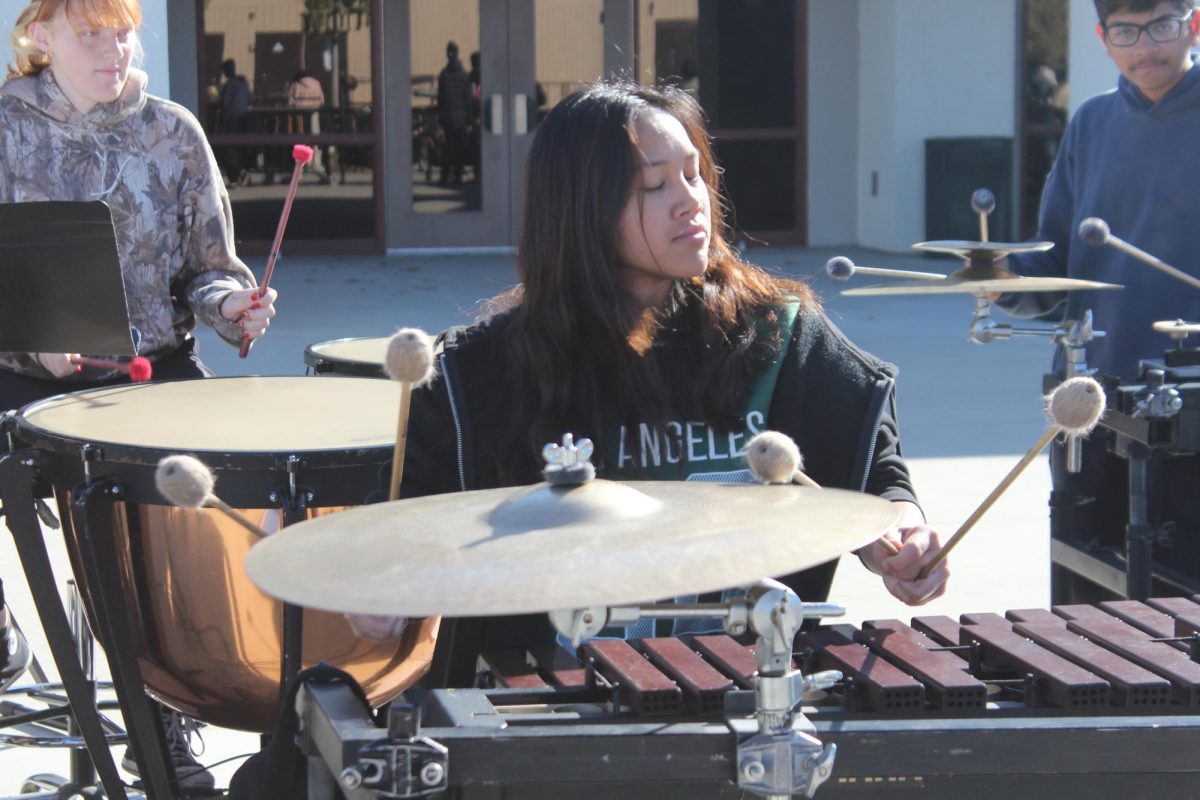As the winter season kicks into full swing, winter percussion and winter guard work hard preparing for their competitive season starting in mid-February and ending in April. From the rhythmic pulse of drumlines to the synchronization of spinning flags, The Paw Print took a behind-the-scenes look at how these teams train and perfect their routines.
Preparing for Winter Percussion
West Ranch’s Percussion team had started their preparations months in advance, with practice days lasting extremely long hours. Sophomore Jake Camia, a player for the snare line, described their restless schedule: “Practices are typically five hours, with occasional practices on Saturdays lasting up to 13 hours.”
During each practice, members learn, train and polish new skills to create the perfect performance. Practice is often split between two sections: the concert show followed by the marching show. When discussing the importance of practice, junior timpani player Rachel Ozhekim shared, “Both parts of our practice help us to break down music between the group, as every part in the music is extremely crucial and needs to be perfect.”
When asked what their favorite part of the process was, both Camia and Ozhekim responded that connecting all parts of the ensemble not only showed off their hard work but also allowed the audience to feel the story being conveyed. Moreover, Ozhekim explained “when the musical and visual aspects all come together in the marching ensemble, it forms the full show and tells a story for the audience.”
Many challenges arise for percussion students throughout the production process, as members expressed the mental preparations for the task. Camia voiced out “It can be extremely mentally challenging as you need to stay focused for that entire time as if you zone out once or become distracted, you can become lost almost instantly. ” a trouble also disclosed by Ozhekim.
Inspiration of Winter Percussion
The Percussion show is split into the concert and marching ensembles, each with distinct music and purpose. The concert ensemble titled “Once in a Blue Moon,” aims to show off the intense skill through a series of difficult pieces. Following that, percussion paints a visual story through various formations of drum lines in the marching ensemble. Titled “Once I am Gone,” the performance “follows a person who has just returned from a funeral and finds a letter on his study desk from the person who passed” Ozhekim explained. The show’s ending conveys a deep message of accepting the loss of a loved one.
Preparing for Winterguard
West Ranch’s winterguard has also started practicing months in advance, and the team is hard at work preparing for their current show, “Wild Horses.” With long rehearsals, physically demanding routines and a deep focus on performance, the team members dedicate countless hours for results.
Winterguard practices take place on Tuesdays and Thursdays from 5 to 9 p.m., along with Saturday rehearsals that range from four to nine hours. Gabriel Santos, a dedicated senior on the team, described their rigorous schedule: “Our practices during winterguard typically take place in the small or big gym, where we spend the majority of our time running reps of our show. We first go over fundamentals with our equipment, then we begin doing runs where we practice not only how to spin together but also how to perform to an audience.”
Despite the intensity, many members find joy in different aspects of the rehearsal process. Santos highlighted his love for full runs at the end of practice: “Winterguard is mainly a sport where you not only spin equipment but also interpret music. I find many ways to express myself through the music, which is what keeps me enjoying guard more and more.”
Junior member Celeste Babakhanian, on the other hand, enjoys the warm-up routines: “Dance fundamentals and across-the-floors are fun, help warm up my body and put me in a focused mindset for the rest of practice.”
However, preparation is not just about learning choreography—it is also about developing discipline and resilience. Babakhanian believes the team gains valuable life skills through training. “We learn how to be efficient, determined, disciplined, and how to persevere through difficulty. We learn the value of teamwork and good work ethic.”
Similarly, Santos emphasized the physical and mental challenges of winter guard: “This is a sport that requires not only physical strength but also a strong mentality. Eye-body coordination is a giant fundamental—it requires you to move with your feet while manipulating a piece of equipment at the same time.”
The Show
This season’s show, “Wild Horses,” promises to be an emotional journey filled with intensity and movement. Babakhanian described the production as “very intense with many emotional ups and downs. Our costumes are flowy brown bodysuits with sparkly gauntlets, and our props are fences that we move throughout the show.” “Wild Horses” is meant to be more than just a performance, but rather an experience that resonates with the audience.
The dedication of winter percussion and color guard behind-the-scenes is clear. Through hours of practice, both teams have prepared for their elaborately choreographed performances. Stay tuned for Winterguard on March 1 to cheer on our brilliant performing arts.








